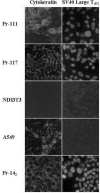Development of PIN and prostate adenocarcinoma cell lines: a model system for multistage tumor progression
- PMID: 11896566
- PMCID: PMC1550323
- DOI: 10.1038/sj.neo.7900210
Development of PIN and prostate adenocarcinoma cell lines: a model system for multistage tumor progression
Abstract
Existing prostate cancer cell lines have been derived from late stages of human prostate cancer. In this paper, we present two cell lines generated from prostatic intraepithelial neoplasia (PIN), the precursor lesion for prostate adenocarcinoma. Pr-111 and Pr-117 were established from PIN lesions that developed in the C3(1)/Tag transgenic model of prostate cancer. Pr-111 and Pr-117 cells express simian virus 40 large T antigen (SV40 Tag) and are immortalized in culture, distinguishing them from normal prostate cells. The growth rates of these two cell lines are quite different; with Pr-111 cells growing much more slowly (doubling time approximately 40 hours) compared to Pr-117 cells (doubling time approximately 22 hours), and also show significantly different growth rates in different media. Both prostate cell lines express cytokeratin and androgen receptor (AR) with Pr-111 cells demonstrating androgen-dependent growth and Pr-117 cells exhibiting androgen-responsive growth characteristics. Athymic nude mice injected with Pr-111 cells either do not develop tumors or develop tumors after a long latency period of 14 weeks. Pr-117 cells, however, develop tumors by 3 to 6 weeks, suggesting that Pr-117 cells represent a later stage of tumor progression. These two novel cell lines will be useful for studying early stages of prostate tumor development and androgen responsiveness.
Figures








Similar articles
-
Development and characterization of a mouse prostate adenocarcinoma cell line: ductal formation determined by extracellular matrix.Prostate. 1998 Jan 1;34(1):10-22. doi: 10.1002/(sici)1097-0045(19980101)34:1<10::aid-pros2>3.0.co;2-o. Prostate. 1998. PMID: 9428383
-
A probasin-large T antigen transgenic mouse line develops prostate adenocarcinoma and neuroendocrine carcinoma with metastatic potential.Cancer Res. 2001 Mar 1;61(5):2239-49. Cancer Res. 2001. PMID: 11280793
-
Androgen-dependent prostate epithelial cell selection by targeting ARR(2)PBneo to the LPB-Tag model of prostate cancer.Lab Invest. 2006 Oct;86(10):1074-88. doi: 10.1038/labinvest.3700463. Epub 2006 Aug 7. Lab Invest. 2006. PMID: 16894353
-
The C3(1)/SV40 T antigen transgenic mouse model of prostate and mammary cancer.Toxicol Pathol. 1998 Jan-Feb;26(1):177-82. doi: 10.1177/019262339802600121. Toxicol Pathol. 1998. PMID: 9502400 Review. No abstract available.
-
Changes in biomarker expression in the development of prostatic adenocarcinoma.Biotech Histochem. 1997 Mar;72(2):86-95. doi: 10.3109/10520299709082217. Biotech Histochem. 1997. PMID: 9152521 Review.
Cited by
-
Macrophages expedite cell proliferation of prostate intraepithelial neoplasia through their downstream target ERK.FEBS J. 2021 Mar;288(6):1871-1886. doi: 10.1111/febs.15541. Epub 2020 Sep 25. FEBS J. 2021. PMID: 32865335 Free PMC article.
-
Macrophages Cytokine Spp1 Increases Growth of Prostate Intraepithelial Neoplasia to Promote Prostate Tumor Progression.Int J Mol Sci. 2022 Apr 12;23(8):4247. doi: 10.3390/ijms23084247. Int J Mol Sci. 2022. PMID: 35457063 Free PMC article.
References
-
- American Cancer Society, author. Cancer Facts and Figures 2001. Atlanta, GA: American Cancer Society; pp. 18–19.
-
- Bostwick DG. Progression of prostatic intraepithelial neoplasia to early invasive adenocarcinoma. Eur Urol. 1996;30:145–152. - PubMed
-
- Bostwick DG. High grade prostatic intraepithelial neoplasia: the most likely precursor of prostate cancer. Cancer. 1995;75:1823–1836.
-
- Bostwick DG, Pacelli A, Lopez-Beltran A. Molecular biology of prostatic intraepithelial neoplasia. Prostate. 1996;29:117–134. - PubMed
-
- Bostwick DG, Brawer MK. Prostatic intra-epithelial neoplasia and early invasion in prostate cancer. Cancer. 1987;59:788–794. - PubMed
Publication types
MeSH terms
Substances
LinkOut - more resources
Full Text Sources
Medical
Research Materials
Miscellaneous
